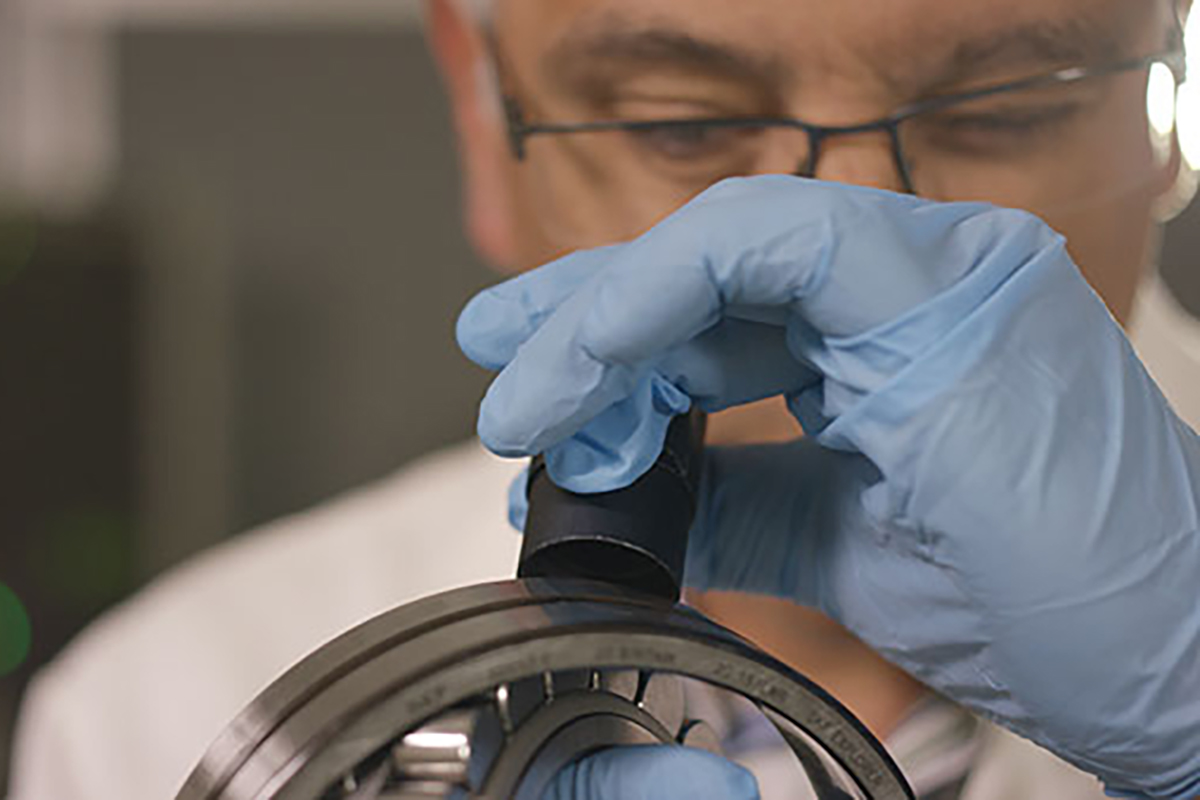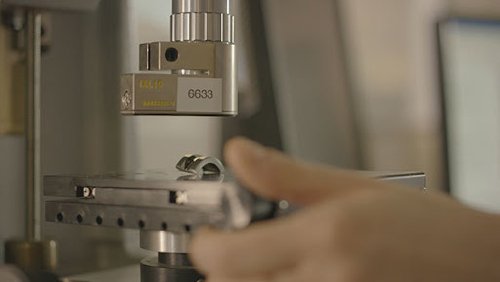
Guillermo Morales-Espejel, principal scientist at SKF Research and Technology Development, examines a bearing. (Photos courtesy of SKF)
The science of bearings continues to improve annually. Research on everything from fatigue behavior and misalignments to mounting errors and tribology has led bearing manufacturers to pinpoint key challenges in rotating machinery and make the necessary adjustments to provide the best possible solution.
In turn, this research provides bearing designers with real-world data that is extremely valuable as new bearings are produced.
It is not efficient to put a bearing with a 20-year lifespan into a machine that’s going to last 10 years. There has to be a happy medium, according to Guillermo Morales-Espejel, principal scientist at SKF Research and Technology Development.
“The goal is to provide a bearing for an application that will last the same lifespan as the machine,” Morales-Espejel said. It’s not a matter of improving the bearing itself, it’s more a matter of improving the predictability of the bearing.”
SKF has spent many years — particularly the Research and Technology Development department — solving the mysteries of bearing performance.
This research has led to hundreds of custom machine designs for some of the world’s most demanding applications.
First some design engineering facts presented during SKF’s technical press event in late 2020:
90% of the bearings in the field outlive the machine when they are designed properly from the start and maintained.9.5% of the bearings are replaced in the field as part of a preventive maintenance strategy.
For so called critical assets (those machines, for example, that determine the bottle neck in a plant) such a preventive strategy could be more cost effective (even if the bearings are still ok) then accepting the risk of an unplanned failure.
As SKF becomes better and better at predicting bearing failures and remaining life, this will enable customers to switch from a preventive maintenance strategy for these machines to a more predictive maintenance strategy, directly saving the cost of unnecessary maintenance and replacements.
0.5% of the bearings are replaced because of failures. From these, 33% fail because of fatigue which you could say is the ‘correct failure mode’ as it is simply cause by the number of load cycles that the bearing material was able to handle.
16% of these failures are caused by improper handling, which includes mounting errors, misalignment etc.
“We inform and educate many of our customers, end users and distributors each year to avoid these errors,” said Bernie van Leeuwen, director at SKF Research and Technology Development. “51% however, is related to so called ‘surface-initiated-failures’, which on their turn can be caused by anything that can (start to) damage the raceway surface of the bearings, including contamination and lack of sufficient lubrication.”
Historically a lot of research and eventually design engineering has been done on the understanding and calculation of the fatigue life.
Through this research, it is clear that a greater understanding of surface-initiated-failures will lead to the increased reliability of rotating machinery, according to van Leeuwen.
SKF unveiled the Generalized Bearing Life Model (GBLM) in 2015 to ensure customers and distributors could select the right bearing for the right application, every time. In the past it was difficult for engineers to predict whether a hybrid bearing could outperform a steel bearing in a given application.

The Generalized Bearing Life Model (GBLM) leads to better choices when selecting bearings.
“From 2015 to 2018, we tested hybrid bearings and began implementing and verifying the model,” Morales-Espejel said. Through this research Morales-Espejel found great potential for hybrid bearings across many different applications. Hybrid bearings use ceramic silicon nitride rolling elements and steel rings. They have been the preferred choice for high-speed, high-precision equipment such as machine tool spindles.
The Generalized Bearing Life Model (GBLM) leads to better choices when selecting bearings.
Today, the hybrid bearing’s combination of low weight, good electrical resistance and good performance under demanding lubrication and contamination conditions is helping it find many new applications, from electric vehicle powertrains to industrial pumps and compressors.
“GBLM enables better choices to be made when selecting bearings for a wide variety of applications,” he added. “We built curves in order to describe the behavior of bearings over a wide range of loads and surface conditions. Hundreds of these bearing tests compared steel and ceramic rolling elements and we were able to finalize a new GBLM for hybrid bearings.”
When a bearing is heavily loaded, but able to run in a clean, well-lubricated environment, sub-surface fatigue is likely to be the ultimate failure mode, and a steel bearing may perform better than a hybrid. But a lot of bearings operate under lighter loads, but with a greater likelihood of poor lubrication or contamination. The SKF model shows if a hybrid solution would offer a longer life on those applications and will quantify the difference.
In a poorly lubricated pump bearing, for example, the rating life of a hybrid bearing can be up to eight times that of a steel equivalent. For a screw compressor bearing running with contaminated lubricant, meanwhile, the hybrid offers a rating lifetime a hundred times greater than a conventional steel bearing.
From railway and car engines to industrial pumps, hybrid bearings can provide the necessary combination of low energy consumption and high reliability. E-mobility is another area where bearings need to survive high speeds, accelerations, and temperatures with minimal lubrication. These bearings must resist stray electric currents, which can burn away lubricant films and damage rolling surfaces. Combined with their other benefits, the excellent electrical insulation properties of hybrid bearings make them the ideal solution for such applications.

SKF’s GBLM calculation tools are being used 260 times a day on average.
SKF’s GBLM calculation tools are being used 260 times a day on average. “When you don’t have tough tribological conditions, there is no need to have a hybrid bearing,” Morales-Espejel said. “Hybrids will tend to introduce more subsurface fatigue that steel to steel bearings particularly with very high loads.” The challenge is comparing the two design types in a variety of different applications and circumstances and compare the results.
“Hybrid bearings don’t always emerge as the winner in comparison with conventional designs. The idea is not to replace all steel-steel bearings with hybrid designs, but to do so when it makes economic sense. Our GBLM for hybrid bearings allows customers to make those decisions based on our data,” Morales-Espejel said.
SKF’s GBLM calculation tools are currently being used 260 times a day on average by the company’s application engineers and customers.
The move from preventative to predictive maintenance strategies will continue in the coming years. Tougher operating conditions will increase the need for more hybrid bearings in the future, according to Morales-Espejel. And with more effort on predictive maintenance, the bearing industry will see a significant increase in smart manufacturing technologies in the coming years.
“We’ll see more sensors on bearings, more field data and intelligent software that will provide additional benefits,” Morales-Espejel said. “The bearing industry will evolve as these tools are combined with good calculation methods, predictive measures and lots of sensors sending information to the models.” New steel bearings will also receive attention in the coming years.
We currently are using new steels in very extreme applications, but these steels are becoming more mainstream.” Morales-Espejel said. “You cannot do some of the things with typical steel bearings in a corrosive environment, you need specialized steel in many of these unique applications. I believe we’ll continue to see an increased demand for specialized steel bearings in the future.” Data collection continues to improve the overall efficiency of bearings, giving customers the ability to make well-informed decisions regarding their applications.
Late last year it was announced that SKF — founded in 1907 — and Imperial College London, were extending their R&D partnership. The SKF University Technology Centre (UTC) has been housed at Imperial College London since 2010 and has delivered research that helps bearings perform better and longer, whilst also contributing to lower energy consumption in the machines they operate in. This work will continue until 2025.
At the end of our conversation on bearing efficiency, I returned to the statement that 90 percent of the bearings in the field outlive the machines when they are properly maintained. Can this number reach 100 percent in the future?
“Manufacturing bearings that are engineered for specific operating conditions typically come with higher costs,” Morales-Espejel said. “The pressure is mounting to provide as much real-time bearing data as possible to help our customers make informed decisions regarding their equipment. Our hope is to use this data to provide more efficient bearings in the future.”

Data collection continues to improve the overall efficiency of bearings, giving customers the ability to make well-informed decisions regarding their applications.